Related Research Articles

Eurotiomycetes is a large class of ascomycetes with cleistothecial ascocarps within the subphylum Pezizomycotina, currently containing around 3810 species according to the Catalogue of Life. It is the third largest lichenized class, with more than 1200 lichen species that are mostly bitunicate in the formation of asci. It contains most of the fungi previously known morphologically as "Plectomycetes".
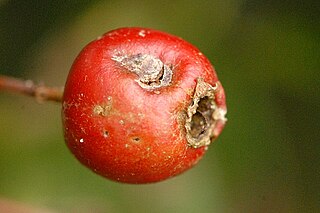
The Venturiaceae are a family of fungi in the order Pleosporales. Several of the species in this family are plant pathogens.

In biology, taxonomic rank is the relative level of a group of organisms in an ancestral or hereditary hierarchy. A common system of biological classification (taxonomy) consists of species, genus, family, order, class, phylum, kingdom, and domain. While older approaches to taxonomic classification were phenomenological, forming groups on the basis of similarities in appearance, organic structure and behaviour, methods based on genetic analysis have opened the road to cladistics.

Geoglossaceae is a family of fungi in the order Geoglossales, class Geoglossomycetes. These fungi are broadly known as earth tongues. The ascocarps of most species in the family Geoglossaceae are terrestrial and are generally small, dark in color, and club-shaped with a height of 2–8 cm. The ascospores are typically light-brown to dark-brown and are often multiseptate. Other species of fungi have been known to parasitize ascocarps. The use of a compound microscope is needed for accurate identification.
The Clypeosphaeriaceae are a family of fungi in the order Xylariales.

The Bionectriaceae are a family of fungi in the order Hypocreales. A 2008 estimate places 35 genera and 281 species in the family. Species in the family tend to grow on plant material, including woody debris, while some species associate with algae, bryophytes, or other fungi.

Nectriopsis is a genus of fungi in the class Sordariomycetes. The number of species in this genus varies between sources. The Dictionary of Fungi lists only 58 species, but the Catalogue of Life includes 72 species.
Pronectria is a genus of fungi in the family Bionectriaceae. It consists of 44 species, all of which are lichenicolous. The genus was circumscribed by American plant ecologist Frederic Clements in 1931.
Trichonectria is a genus of fungi in the class Sordariomycetes.
The Saccardiaceae are a family of fungi in the Ascomycota phylum. This family can not yet be taxonomically classified in any of the ascomycetous classes and orders with any degree of certainty . They have a worldwide distribution.
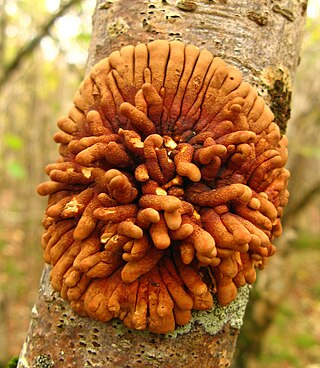
Hypocreopsis is a genus of ascomycete fungi that form stromata on the stems of trees and shrubs. The stromata are orange-brown and consist of radiating, perithecial lobes.

Fred Jay Seaver was an American mycologist. He worked at the New York Botanical Garden for 40 years, initially as the Director of Laboratories (1908–1911), then as the Curator (1912–1943), and finally as Head Curator (1943–1948). He was also an editor of the journal Mycologia between 1909 and 1947. In 1928, Seaver published North American Cup-fungi (Operculates), which was expanded with a supplement in 1942 and a second volume in 1951, titled North American Cup-fungi (Inoperculates).
Albonectria is a genus of ascomycete fungi in the family Nectriaceae.

Corallomycetella is a genus of ascomycete fungi in the family Nectriaceae. Species of Corallomycetella are tropical, and are characterized by the formation of brightly colored rhizomorphs of their rhizostilbella-like asexual morphs. These fungi causes a number of plant diseases including 'violet root rot' of Theobroma cacao, root rot of Carica papaya, and 'stinking root disease' of several tropical woody plants. Two species of Corallomycetella are recognized: Corallomycetella elegans C. Herrera & P. Chaverri and Corallomycetella repens Rossman & Samuels. Corallomycetella jatrophae is now classified under Corallonectria.

Cosmospora is a genus of ascomycete fungi in the family Nectriaceae. The genus, as circumscribed by Rossman et al. (1998), included all the nectrioid species with small, reddish, non-ornamented sexual fruiting bodies that collapse laterally when dry. However, the genus was shown to be polyphyletic, and the majority of species were re-classified into revived or recently established genera that are monophyletic. Cosmosporasensu Rossman housed members of the following genera: Chaetopsina, Cylindrocladiella, Fusicolla, Macroconia, Mariannaea, Microcera, Pseudocosmospora, Stylonectria, and Volutella. Cosmospora was restricted to species having acremonium-like asexual morphs that grow on polypores and xylariaceous fungi by Gräfenhan in 2011. About 20 species are accepted in the genus.
Margaret Elizabeth Barr Bigelow (1923-2008) was a Canadian mycologist known for her contributions to the Ascomycetes fungi.
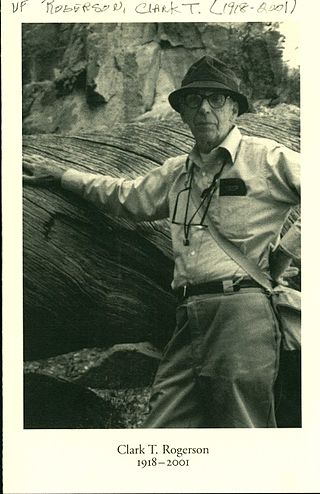
Clark Thomas Rogerson,, was an American mycologist. He was known for his work in the Hypocreales (Ascomycota), particularly Hypomyces, a genus of fungi that parasitize other fungi. After receiving his doctorate from Cornell University in 1950, he went on to join the faculty of Kansas State University. In 1958, he became a curator at The New York Botanical Garden, and served as editor for various academic journals published by the Garden. Rogerson was involved with the Mycological Society of America, serving in various positions, including president in 1969. He was managing editor (1958–89) and editor-in-chief (1960–65) of the scientific journal Mycologia.

Glutinoglossum is a genus of six species of earth-tongue fungi in the family Geoglossaceae. The widespread type species, G. glutinosum, is commonly known as the "glutinous earth tongue". G. heptaseptatum is known only from the Czech Republic. Four additional species were described in 2015.
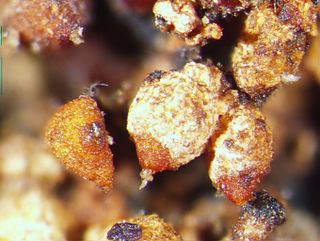
Corallonectria is a genus of ascomycete fungi in the family Nectriaceae. Species of Corallonectria are Neotropical. These fungi are characterized by the formation of brightly colored rhizomorphs and of copulated synnematous fusarium-like asexual morphs in culture. The asexual morph in nature has been rarely observed. The sexual fruiting bodies are furfuraceous and usually seated at the base of a reddish synnemata. It is a monotypic genus containing the sole species Corallonectria jatrophae. This species was formerly classified under Corallomycetella.
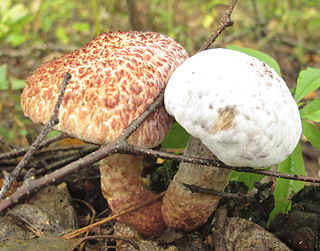
Hypomyces completus is a parasitic ascomycete in the order Hypocreales. The fungus grows on boletes, typically Suillus spraguei in North America, although the type collection was found on growing on Boletinus oxydabilis in Siberia. The color of its subiculum ranges from white initially to yellow-brown to greenish-brown to brown to black; the fruitbodies (perithecia) range from pale brown to dark brown to black. Spores measure 35–40 by 4–6 μm.
References
- ↑ Kirk PM, Cannon PF, Minter DW, Stalpers JA (2008). Dictionary of the Fungi (10th ed.). Wallingford, UK: CAB International. p. 419. ISBN 978-0-85199-826-8.
- ↑ Samuels GJ, Rogerson CT (1990). "New Ascomycetes from the Guayana Highland". Memoirs of the New York Botanical Garden. 64: 165–83.